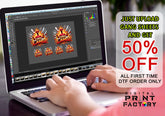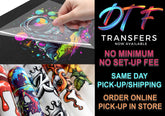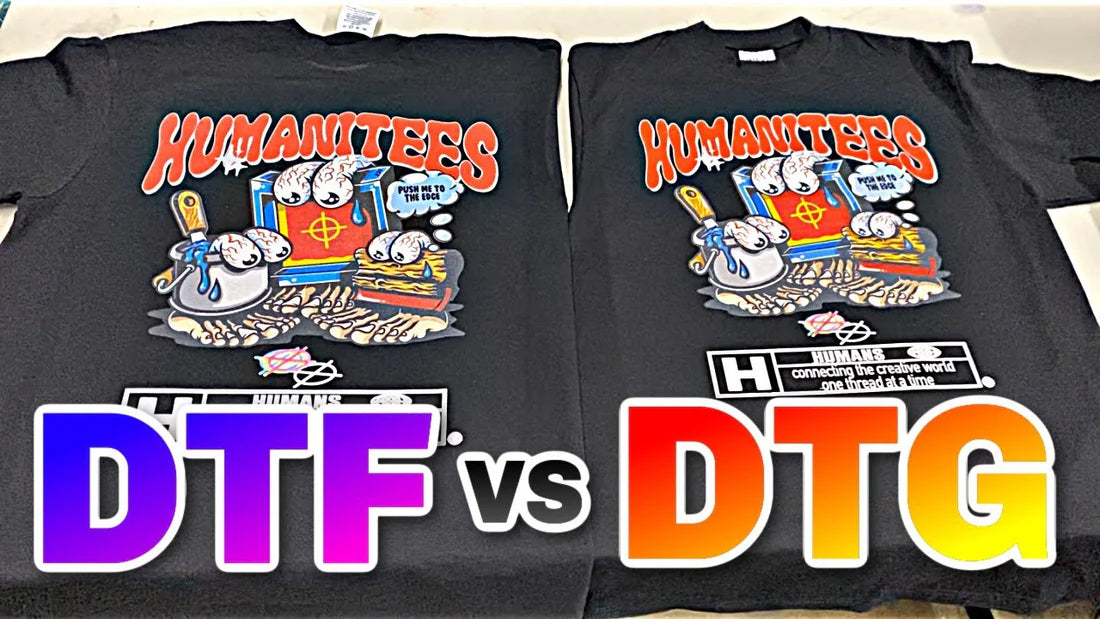In the world of custom apparel printing, two popular technologies are often compared: DTF (Direct to Film) and DTG (Direct to Garment). Both have unique benefits and are suitable for different applications. Understanding the differences between DTF and DTG printing can help you determine the best choice for your needs. This article will explore the main distinctions, advantages, and considerations to help you decide between DTF and DTG printing.
What is DTF (Direct to Film) Printing?
Direct to Film (DTF) printing is a relatively new printing technique that involves printing your design onto a special film and then transferring it to fabric using a heat press. This method is known for its versatility, as it works well on a wide range of fabrics, including cotton, polyester, blends, and even more unconventional materials like leather.
Benefits of DTF Printing:
Versatility Across Fabrics: DTF printing can be used on a variety of materials, making it a flexible choice for printing on not just clothing but also accessories and hard surfaces.
Durability: Prints made using DTF technology are highly durable, able to withstand multiple washes without cracking or fading, which is ideal for long-lasting designs.
Vivid Color Output: DTF allows for vibrant, full-color designs with excellent detail, making it suitable for intricate and colorful artwork.
Cost-Effective for Small Batches: DTF is particularly cost-effective for smaller print runs or custom orders, making it a great option for small businesses or individuals.
What is DTG (Direct to Garment) Printing?
Direct to Garment (DTG) printing is a digital printing method that applies ink directly onto the fabric using specialized inkjet technology. This process is ideal for printing on cotton fabrics and is known for its ability to produce high-resolution, photo-quality images.Benefits of DTG Printing:
High-Quality Image Reproduction: DTG printing is excellent for producing detailed, high-resolution prints, making it ideal for designs with fine details and photographic images.
Soft Hand Feel: Because the ink is absorbed directly into the fabric, DTG prints have a soft, smooth feel, providing a comfortable wear experience.
Eco-Friendly Options: DTG printing typically uses water-based inks, which are more environmentally friendly compared to some traditional printing methods.
Ideal for On-Demand Printing: DTG is perfect for on-demand printing, allowing businesses to print only what they need, reducing inventory waste and costs.
Comparing DTF and DTG Printing
Printing Process:
- DTF involves printing a design onto a film and then using a heat press to transfer the design onto the fabric. This method is versatile across different materials.
- DTG prints the design directly onto the fabric using an inkjet printer, which is best suited for natural fibers like cotton.
Material Compatibility:
- DTF is compatible with a wide range of materials, including cotton, polyester, blends, and more, making it more versatile.
- DTG works best with cotton or cotton-blend fabrics and is less effective on synthetic materials unless specially treated.
Durability and Texture:
- DTF prints are durable and can endure repeated washes without significant wear, but may feel slightly textured due to the film transfer.
- DTG prints are soft to the touch because the ink becomes part of the fabric, but they may not be as durable on synthetic materials or if not cared for properly.
Color Quality and Detail:
- DTF provides vibrant colors and excellent detail, making it suitable for designs with a lot of variation and color depth.
- DTG is exceptional for detailed images and smooth color gradients, especially useful for photo-realistic prints.
Cost and Efficiency:
- DTF is often more cost-effective for small batches and custom jobs due to its minimal setup requirements.
- DTG is also cost-effective for short runs and on-demand production, though the per-print cost may be higher due to ink and maintenance costs.
Deciding Between DTF and DTG
Choosing between DTF and DTG printing depends on your specific needs and the type of products you plan to create:
> Go with DTF if you need a versatile printing solution that works on a variety of materials and offers durability and vibrant color, especially for smaller print quantities or diverse applications.
> Opt for DTG if you want high-quality, photo-realistic prints on cotton garments with a soft feel and prefer an eco-friendly ink option, particularly for on-demand printing.
Conclusion
Both DTF and DTG printing methods have their own strengths and are suited for different purposes. By understanding the key differences and benefits of each, you can choose the printing method that best aligns with your goals, whether for custom apparel, personalized gifts, or promotional products. Whether you choose DTF or DTG, both provide reliable, high-quality printing options to meet your needs.









